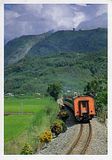

Poenari Castle also known as Poenari Citadel (Cetatea Poenari in Romanian), is a ruined castle in Romania, in Argeş County (Căpăţânenii Pământeni village of the Arefu commune) on a canyon formed on the Argeş River valley, close to the Făgăraş Mountains. It stands on a cliff, on the right side of the Transfăgărăşan road which climbs high into the mountains. Poenari Castle is said to be one of the most haunted places in the world. It was erected around the beginning of the 13th century by the first Romanian rulers in the South region of Romania, known as Wallachia. Around the 14th century, Poenari was the main citadel of the Basarab rulers. In the next few decades, the name and the residents changed a few times but eventually the castle was abandoned and left in ruins. However, in the 15th century, realizing the potential for a castle perched high on a steep precipice of rock, Vlad III the Impaler repaired and consolidated the structure, making it one of his main fortresses.
Although the castle was used for many years after Vlad's death in 1476, it eventually was abandoned again in the first half of the 16th century and was in ruins by the 17th century. Due to its size and location, control of the castle was difficult to take, even by natural forces. However, in 1888, a landslide brought down a portion of the castle which crashed into the river far below. Nonetheless, the castle was slightly repaired and the walls and its towers still stand today. To reach the castle, visitors need to climb 1.500 steps.
Although the castle was used for many years after Vlad's death in 1476, it eventually was abandoned again in the first half of the 16th century and was in ruins by the 17th century. Due to its size and location, control of the castle was difficult to take, even by natural forces. However, in 1888, a landslide brought down a portion of the castle which crashed into the river far below. Nonetheless, the castle was slightly repaired and the walls and its towers still stand today. To reach the castle, visitors need to climb 1.500 steps.



.jpg)



























No comments:
Post a Comment